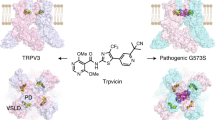Abstract
The transient receptor potential vanilloid 1 (TRPV1) is a member of nonselective cation channels and has been implicated in the progression of neurogenic inflammation and nociception. Through the synthesis of over 2,000 new compounds, a novel non-vanilloid TRPV1 antagonist PAC-14028 was discovered. As well as ideal physicochemical and pharmacokinetic properties, PAC-14028 showed meaningful efficacies against diverse disease models that include visceral pain, inflammatory bowel disease, and inflammatory pain. Of note, PAC-14028 effectively attenuates atopic dermatitis and pruritus without significant adverse effects, which is a substantial benefit over conventional pharmacotherapy. This report introduces the potential of a novel TRPV1 antagonist PAC-14028 as a new drug for atopic dermatitis and pruritus.
Similar content being viewed by others
References
Caterina, M. J., The capsaicin receptor: a heat-activated ion channel in the pain pathway. Nature, 389, 816–824 (1997).
Caterina, M. J., Leffler, A., Malmberg, A. B., Martin, W. J., Trafton, J., Petersen-Zeitz, K. R., Koltzenburg, M., Basbaum, A. I., and Julius, D., Impaired nociception and pain sensation in mice lacking the capsaicin receptor. Science, 288, 306–313 (2000).
Chizh, B. A., The effects of the TRPV1 antagonist SB-705498 on TRPV1 receptor-mediated activity and inflammatory hyperalgesia in humans. Pain, 132, 132–141 (2007).
Garami, A., Shimansky, Y. P., Pakai, E., Oliveira, D. L., Gavva, N. R., and Romanovsky, A. A., Contributions of different modes of TRPV1 activation to TRPV1 antagonistinduced hyperthermia. J. Neurosci., 30, 1435–1440 (2010).
Gavva, N. R., Pharmacological blockade of the vanilloid receptor TRPV1 elicits marked hyperthermia in humans. Pain, 136, 202–210 (2008).
Iida, T., Shimizu, I., Nealen, M. L., Campbell, A., and Caterina, M., Attenuated fever response in mice lacking TRPV1. Neurosci. Lett., 378, 28–33 (2005).
Park, H. G., Park, M. K., Choi, J. Y., Choi, S. H., Lee, J., Park, B. S., Kim, M. G., Suh, Y. G., Cho, H., Oh, U., Kim, H. D., Park, Y. H., Koh, H. J., Lim, K. M., Moh, J. H., and Jew, S. S., Synthesis of N,N,N-trisubstituted thiourea derivatives and their antagonist effect on the vanilloid receptor. Bioorg. Med. Chem. Lett., 13, 601–604 (2003).
Park, Y. H., Joo, K. M., Woo, B. Y., Son, E. D., Byun, S. Y., Shin, H. J., Lee, K. W., Park, Y. H., and Lim, K. M., Oral and topical pharmacokinetic studies of a novel TRPV1 antagonist, PAC-14028 in rats and minipigs using liquid chromatography/tandem mass spectrometric method. J. Pharm. Biomed. Anal., 61, 8–14 (2012).
Saria, A., Martling, C. R., Yan, Z., Theodorsson-Norheim, E., Gamse, R., and Lundberg, J. M., Release of multiple tachykinins from capsaicin-sensitive sensory nerves in the lung by bradykinin, histamine, dimethylphenyl piperazinium, and vagal nerve stimulation. Am. Rev. Respir Dis., 137, 1330–1335 (1988).
Scholz, J. and Woolf, C. J., Can we conquer pain? Nat. Neurosci., 5 Suppl, 1062–1067 (2002).
Steinhoff, M., Bienenstock, J., Schmelz, M., Maurer, M., Wei, E., and Bíró, T., Neurophysiological, neuroimmunological, and neuroendocrine basis of pruritus. J. Invest. Dermatol., 126, 1705–1718 (2006).
Suh, Y. G., Lee, Y. S., Min, K. H., Park, O. H., Kim, J. K., Seung, H. S., Seo, S. Y., Lee, B. Y., Nam, Y. H., Lee, K. O., Kim, H. D., Park, H. G., Lee, J., Oh, U., Lim, J. O., Kang, S.U., Kil, M. J., Koo, J. Y., Shin, S. S., Joo, Y. H., Kim, J. K., Jeong, Y. S., Kim, S. Y., and Park, Y. H., Novel potent antagonists of transient receptor potential channel, vanilloid subfamily member 1: structure-activity relationship of 1,3-diarylalkyl thioureas possessing new vanilloid equivalents. J. Med. Chem., 48, 5823–5836 (2005).
Szallasi, A., Cortright, D. N., Blum, C. A., and Eid, S. R., The vanilloid receptor TRPV1, 10 years from channel cloning to antagonist proof-of-concept. Nat. Rev. Drug Discov., 6 357–372 (2007).
Wu, L. J., Sweet, T. B., and Clapham, D. E., International union of basic and clinical pharmacology. LXXVI. Current progress in the mammalian TRP ion channel family. Pharmacol. Rev., 62, 381–404 (2010).
Yun, J. W., Seo, J. A., Jang, W. H., Koh, H. J., Bae, I. H., Park, Y. H., and Lim, K. M., Antipruritic effects of TRPV1 antagonist in murine atopic dermatitis and itching models. J. Invest. Dermatol., 131, 1576–1579 (2011a).
Yun, J. W., Seo, J. A., Jeong, Y. S., Bae, I. H., Jang, W. H., Lee, J., Kim, S. Y., Shin, S. S., Woo, B. Y., Lee, K. W., Lim, K. M., and Park, Y. H., TRPV1 antagonist can suppress the atopic dermatitis-like symptoms by accelerating skin barrier recovery. J. Dermatol. Sci., 62, 8–15 (2011b).
Author information
Authors and Affiliations
Corresponding authors
Additional information
Edited by Mi-Kyoung Kwak, College of Pharmacy (Rm 408), The Catholic University of Korea, Bucheon 420-743, Korea Tel: 82-2-2164-6532 E-mail: mkwak@catholic.ac.kr
Young-Ho Park Medical Beauty Research Institute, Amorepacific Corporation R&D Center Main Research Area Biochemistry: TRPV1, PAR-2 Pharmacology: Pain, Inflammation Development of Dermatological Drug, Quasi-Drug and Functional Cosmetic Ingredients
Rights and permissions
About this article
Cite this article
Lim, KM., Park, YH. Development of PAC-14028, a novel transient receptor potential vanilloid type 1 (TRPV1) channel antagonist as a new drug for refractory skin diseases. Arch. Pharm. Res. 35, 393–396 (2012). https://doi.org/10.1007/s12272-012-0321-6
Published:
Issue Date:
DOI: https://doi.org/10.1007/s12272-012-0321-6




